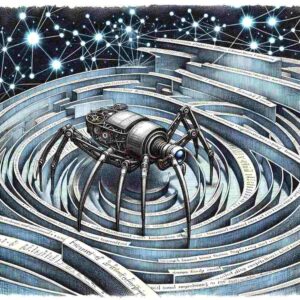What Is SEO?
For those unfamiliar with the concept, ‘Search Engine Optimization’ or SEO, may appear as a technical buzzword known only to IT professionals. However, today’s increasingly online environment demands otherwise. Everyone, from bloggers to businessmen, needs to grasp the fundamentals of SEO and its categorical significance in the digital marketplace.
In its simplest form, SEO refers to the practice of enhancing your website’s visibility in organic (free, natural, or editorial) search results on search engines like Google. The ultimate goal– to attract quality traffic in larger quantity towards your webpage through non-paid methods, thereby improving your site’s ranking in Search Engine Result Pages (SERPs).
The keywords here are quality and quantity. While increasing footfall on your web pages is essential, utmost priority must be given to pulling in ‘targeted traffic‘. These are visitors genuinely interested in your products or services, who’ll likely convert into customers.
Words such as ‘organic search’ and ‘search engine visibility’ might seem complex at first glance, but they boil down to how your website appears on unpaid search results. If your website is optimized for search engines, it means users searching relevant keywords will see your webpages among the top search results.
‘Website optimization’ encompasses numerous elements that influence how search engines evaluate and rank your site. It involves implementing strategies that cater not just to search engines, but also to your audience’s preferences and behaviours. An optimally structured website garners much interest and interaction from users, again influencing higher rankings.
This initial understanding of SEO empowers you with the knowledge that your website’s success is not just about having a visually appealing interface or high-quality content. Instead, it’s a complex process of ensuring your webpages are easily discoverable and appealing to your target audience through search engines.
SEO is not a one-time task but an ongoing effort. As the online landscape evolves, so does the algorithm of search engines. Staying on top of these changes and constantly tinkering with your SEO strategies ensures that you continue to enjoy visibility and draw targeted traffic to your website.
As we progress through this article, we hope to demystify SEO and provide you with effective strategies for optimizing your webpage visibility. Whether you’re a beginner at digital marketing or a seasoned professional looking to tweak your practices, this comprehensive guide on SEO will help you stay ahead of your competitors in this increasingly digital world.

Explanation of How Search Engines Work
To fully comprehend the gravity of SEO, it’s essential to understand how search engines, such as Google, function. Every day, billions of people use Google for a myriad of reasons; from obtaining academic scholarly articles to finding the best restaurants nearby. Behind these seemingly simple searches, there lies a myriad of complex processes involving specialized software known as ‘search spiders’, or more technically, web crawlers.
Web crawlers are automated software which browse (or ‘crawl’) through millions of web pages on the internet. Their modus operandi involves visiting web pages and creating a copy of them to be stored in their vast database, termed as an index. This index is later scanned by search algorithms each time a user enters a query into the search bar.
The algorithms used by these search engines are immensely intricate pieces of technology. They are designed to analyse the indexed data from web crawlers and find the most relevant pages for a given keyword or phrase. Factors such as relevance and usability play a significant role in determining which pages make it to the top results.
SEO essentially aims at optimizing your website so that these web crawlers can easily discover your web pages and interpret their content efficiently. This means when users type keywords related to your business into Google, your pages would show up in the organic, non-paid section of their search results.
Your position or ranking on this list is crucial because websites appearing on the first page of Google’s search results receive almost 95% of the web traffic, leaving only about 5% for remaining search result pages. Therefore, if you want users to find your website without paid advertisements, you must strive to secure a good ranking on SERPs (Search Engine Result Pages).
Astonishingly, it’s not just about including popular keywords in your content. Search engine algorithms have become increasingly sophisticated, using over 200 factors to rank web pages! These can range from existing backlinks, site loading speed, mobile-friendliness to even the freshness of your content.
Understanding and accommodating these myriad factors form the basis of SEO. It’s an art and science of making your website friendly not just to the search spiders but also to your target audience. So when your potential customers search for products or services that you offer, they find you at the top of their search results.
While this may sound complicated initially, bear with us. As we delve into the depths of SEO practices in the forthcoming sections of this guide, you’ll discover practical methods to make your website more visible and enticing for both Google and its users alike.

Elements of Effective SEO
Now that we have delved into the basics of SEO and how search engines work, it’s time to shed light on the various elements that contribute to a successful SEO strategy. Understanding these key areas will provide you with the skills needed to optimize your website for both search engines and your audience.
The fundamental element of effective SEO is content optimization. Content is the core of your website; it’s what attracts visitors in the first place and keeps them coming back for more. But from an SEO perspective, creating quality content isn’t enough. Your content needs to be structured and optimized in a way that makes it easy for search spiders to understand and index correctly.
Content optimization involves strategically using keywords throughout your content, without compromising its readability. This includes incorporating them into your page titles, meta descriptions, headings (H1, H2, etc.), and body text. However, remember that stuffing your content with tons of keywords can severely harm your rankings as Google sees it as spamming.
Another critical aspect of effective SEO is improving the visibility and appearance of your web pages on SERPs. When people conduct searches on Google or any other search engine, they tend to click on results that catch their attention quickly. Page title and meta description play significant roles here because they are typically what users see first in search results.
The positioning of your site in search results matters as well because studies show that higher-ranking websites get significantly more clicks than those below them. Improving the position of your website in organic search results usually requires consistency in optimizing elements such as high-quality inbound links, relevant content, site speed, mobile-friendliness, and others.
A well-structured website, both in terms of design and navigation, also plays a crucial role in SEO. A good website structure helps search spiders easily crawl your site and index its pages. Moreover, it provides users with a pleasant browsing experience, encouraging them to stay longer and explore more pages on your site. This increases dwell time (the amount of time visitors spend on your site), which is a positive ranking signal for Google.
The process of structuring your website’s pages should be logical and straightforward: organize your content in a way that makes sense to both your visitors and search crawlers. Clarity and simplicity are key here; avoid complicated menus or too many sub-pages.
Lastly, a solid SEO strategy aims to improve the overall quality and quantity of traffic coming to the website. It’s not just about increasing numbers, but attracting visitors who are genuinely interested in what you offer and can convert into customers. Quality traffic means those users who are likely to engage with your web-pages longer, share your content or patronize your offerings.
In the following parts of this comprehensive guide, we will delve further into each of these elements and provide effective strategies for maximizing their potential to enhance visibility and direct targeted traffic towards your website.
Achieving High Positioning
After understanding the basics of SEO and exploring various strategies to optimize your website, let’s shift our focus to a critical aspect – achieving a high position in search engine results. Securing top ranks on Search Engine Result Pages (SERPs) is crucial for driving organic, non-paid traffic towards your site. However, this task may seem daunting given that competition is fierce, with countless other websites vying for the same spots.
The first step to attaining a high position involves comprehending how Google or any search engine assigns rankings. The algorithm used by search engines takes into account multiple factors, including content relevance, keyword density, backlinks from other sites, mobile-friendliness, page speed and more. Your ‘Organic Rankings’, technically refer to your site’s standing within these non-paid results.
Improving your organic ranking initiates with providing quality content. This cannot be stressed enough. Content quality trumps every other factor when it comes to positioning. Search engines reward sites that host relevant, helpful content that users appreciate and engage with regularly.
In addition to offering superior content, boosting keyword usage in your webpages can work wonders for your ranking. But remember, keyword stuffing or overusing keywords can lead to penalties from search engines. The best practice is to incorporate them naturally in your titles, meta description and body content without compromising readability.
Backlinks, which are links from external sites pointing towards your website, significantly influence your SERP rank. Backlinks are viewed as votes of confidence by search engines and indicate that others find your site valuable. Therefore, cultivating high-quality backlinks from reputable sources should be an integral part of your SEO strategy.
Technical SEO aspects such as page loading speed, mobile optimization and secure browsing (HTTPS) also influence your site’s SERP ranking. Search engines prefer sites that load swiftly, are responsive across various devices and ensure safe browsing for users.
While on the quest of achieving a top position in search results, it’s paramount to be wary of black hat SEO tactics. These undesirable techniques include keyword stuffing, hidden texts, irrelevant backlinks and more. Although these might offer temporary success, they run the risk of penalties or even being completely removed from search engine results.
For sustainable high positioning, adhering to white hat SEO practices, which are ethical and approved by search engines is vital. These include offering quality content, using relevant keywords, providing a great user experience and building natural backlinks.
Achieving a high rank on SERPs requires patience and diligence. There’s no quick fix or one-size-fits-all solution. It demands consistent application of multiple strategies over time coupled with regular monitoring of your website’s performance.
In the following sections of this guide, we will delve deeper into some advanced methods and tools you can leverage to boost your website’s organic rankings and thus enhance its visibility online.

Directing Targeted Traffic
In the realm of digital marketing, attracting a high volume of traffic to your website is undoubtedly essential. However, the real success lies in drawing targeted traffic. Unlike random visitors, targeted traffic comprises users who are genuinely interested in what you offer and are more likely to convert into customers. This objective largely relies on utilizing advanced SEO strategies effectively.
The first step toward directing more targeted traffic involves understanding your audience thoroughly. You should know who they are, where they come from, and what they’re looking for on your site. By gathering comprehensive insights about demographics, purchase history, browsing behaviour, etc., you can tailor your SEO practices to attract users that have a high potential for conversion.
An essential aspect of acquiring targeted traffic revolves around using long-tail keywords. A long-tail keyword is a specific search phrase containing three or more words. Even though these keywords usually generate less total traffic than broader terms, they tend to have higher conversion rates because they are more specific and relevant to user’s precise needs.
For instance, a user searching “buy size 8 red sneakers online” is likely closer to making a purchase than one just searching “sneakers“. So while the latter may bring larger volumes of traffic, chances of conversions are greater with the former’s more targeted audience. Hence incorporating long-tail keywords in your content can be a massive step towards attracting more targeted traffic.
Another effective approach focuses on enhancing visibility through local SEO. If you’re running a business with physical locations or offering services in specific areas, optimizing for local searches can help draw more targeted visitors. This includes including location-specific keywords in your content and optimizing for ‘near me’ searches which have become increasingly popular today.
Beyond this, an optimized website which loads quickly, is mobile-friendly and easy to navigate also plays a significant role in attracting & keeping targeted traffic. A slow-loading or confusing site may turn away potential customers, regardless of how relevant your content is.
Engaging content that provides immense value to users is another crucial factor. By creating content that addresses the queries, interests and problems of your audience, you not only attract but also retain high-quality traffic.
Finally, remember to monitor your website’s performance routinely using analytics tools. This data will offer insights on where your visitors are coming from, which pages they visit most, what keywords bring them to your site and more. By understanding these patterns, you can refine your SEO strategies for better targeting.
Driving targeted traffic involves many variables yet with the right strategies and consistent efforts; you can make sure your website attracts visitors who are genuinely interested and likely to convert. As we move ahead in this comprehensive guide to mastering SEO, we will delve into practical ways to track the impact of these practices through analytical tools and methods.
Monitoring Improvement & Measuring Success
Implementing effective SEO strategies is just the beginning. To truly master SEO, you need to continuously monitor your progress and measure the success of your efforts. This final section of our comprehensive guide will provide you with insights on using analytical tools to assess the outcomes of your SEO strategies and iteratively improve them.
One of the key goals of monitoring improvement is benchmarking your current performance. By establishing a baseline and comparing it with future results, you can track the impact of your SEO efforts over time. This allows you to identify trends, make data-driven decisions, and refine your strategies for optimal results.
Regularly checking your positions in search results is an important aspect of monitoring improvement. Use tools like Google Search Console or third-party keyword tracking software to see where your web pages rank for specific keywords. By tracking changes in rankings, you can determine which strategies are working and identify areas that require further optimization.
Tracking changes in traffic volume is another crucial metric to gauge the success of your SEO endeavours. Analytical tools like Google Analytics provide valuable insights into how users are finding and interacting with your website. Pay attention to metrics such as total visits, unique visitors, bounce rate, and average session duration to get an accurate picture of user behaviour.
In addition to tracking overall traffic, it’s vital to understand the sources from which visitors are coming to your site. Analyse referral traffic from external websites and organic traffic from search engines to evaluate how effectively you’re attracting targeted visitors. This information helps you prioritize marketing efforts and allocate resources accordingly.
An essential aspect of monitoring improvement is analysing the keywords that bring visitors to your site. Tools like Google Search Console or SEMrush can provide valuable data on the keywords driving organic traffic to each page on your website. Use this information to optimize existing content or create new content targeting relevant keywords with high potential for conversion.
Measuring the success of your SEO efforts goes beyond just analysing website data; it also involves gathering feedback and insights directly from users. Encourage visitors to leave reviews or complete surveys to understand their satisfaction levels and identify areas for improvement. This qualitative feedback complements quantitative data by providing deeper insights into user preferences and expectations.
The iterative nature of SEO necessitates an ongoing process of improvement based on continuous analysis and experimentation. A/B testing different elements of your website, such as landing pages, call-to-action buttons, or meta descriptions, allows you to compare performance metrics and make data-driven decisions on what works best for your audience.
As technology evolves, so do analytical tools. Stay updated with advancements in analytics platforms and experiment with new features that can provide additional insights into user behaviour. For example, consider implementing heatmaps or user session recordings to gain a better understanding of how visitors navigate through your site.
Finally, don’t forget the importance of setting goals and tracking key performance indicators (KPIs) related to SEO. Whether it’s increasing organic traffic by a certain percentage or improving ranking positions for specific keywords, having clear benchmarks helps you stay focused and measure success accurately.
In conclusion, mastering SEO requires not only implementing effective strategies but also continuously monitoring improvement and measuring success. By regularly analysing website data, tracking keyword rankings, evaluating traffic sources, gathering user feedback, conducting A/B testing, and setting clear goals, you can optimize your SEO efforts for maximum impact.
This concludes our comprehensive guide on unlocking SEO: mastering organic website visibility & optimizing your traffic. We hope this article has provided you with valuable insights into the world of search engine optimization and equipped you with practical strategies to enhance your website’s online presence.
Remember that SEO is an ever-evolving field, so it’s essential to stay updated with industry trends and adapt your strategies accordingly. Keep experimenting, learning from both successes and failures, and staying proactive in improving your website’s visibility in search engine results.
We wish you all the best on your journey towards becoming an SEO expert!

